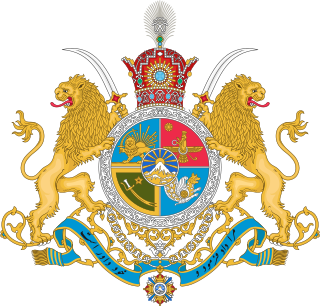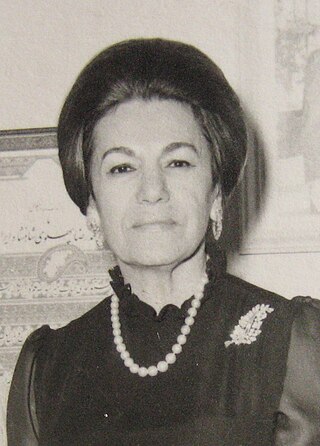Pahlavi may refer to:
Pahlavi may refer to:
Parthian may refer to:

Reza Shah Pahlavi was an Iranian military officer and the founder of the Pahlavi dynasty. As a politician, he previously served as minister of war and prime minister of Qajar Iran and subsequently reigned as Shah of Pahlavi Iran from 1925 until he was forced to abdicate after the Anglo-Soviet invasion of Iran in 1941. He was succeeded by his eldest son, Mohammad Reza Shah. A modernizer, Reza Shah clashed with the Shia clergy, but also introduced many social, economic, and political reforms during his reign, ultimately laying the foundation of the modern Iranian State. Therefore, he is regarded by many as the founder of modern Iran.

The Pahlavi dynasty is an Iranian royal dynasty that ruled for almost 54 years between 1925 and 1979. The dynasty was founded by Reza Shah Pahlavi, a non-aristocratic Mazanderani soldier in modern times, who took on the name of the Pahlavi language spoken in the pre-Islamic Sasanian Empire to strengthen his nationalist credentials.

Shahbanu was the title for empress regnant or empress consort in Persian and other Iranian languages. The two Sassanian empresses regnant, Boran and Azarmidokht, c. 630, were the last two that carried the title before Farah Pahlavi, the wife of Mohammad Reza Pahlavi, the last Shah of Iran (Persia), assumed the title for the first time since the Muslim conquest of Persia in the 7th century.

Reza Pahlavi, Crown Prince of Iran is the oldest son of Mohammad Reza Pahlavi, the last Shah of Iran, and his wife Farah Diba. Before the Islamic Revolution in 1979, he was the crown prince and the last heir apparent to the throne of the Imperial State of Iran. Today, Pahlavi resides in Great Falls, Virginia.

The Iranian National Jewels, originally the Iranian Crown Jewels, include elaborate crowns, thirty tiaras, and numerous aigrettes, a dozen bejeweled swords and shields, a number of unset precious gems, numerous plates and other dining services cast in precious metals and encrusted with gems, and several other more unusual items collected or worn by the Persian monarchs from the 16th century and on. The collection is housed at the Treasury of National Jewels, situated inside the Central Bank of Iran on Tehran's Ferdowsi Street.
Ali Reza Pahlavi was a member of the Pahlavi imperial family of the Imperial State of Iran. He was the younger son of Mohammad Reza Pahlavi, the former Shah of Iran and his third wife Farah Diba. He was second in order of succession to the Iranian throne before the Iranian Revolution.

Shahnaz Pahlavi is the first child of the Shah of Iran, Mohammad Reza Pahlavi, and his first wife, Princess Fawzia of Egypt.
The Parthian language, also known as Arsacid Pahlavi and Pahlawānīg, is an extinct ancient Northwestern Iranian language once spoken in Parthia, a region situated in present-day northeastern Iran and Turkmenistan. Parthian was the language of state of the Arsacid Parthian Empire, as well as of its eponymous branches of the Arsacid dynasty of Armenia, Arsacid dynasty of Iberia, and the Arsacid dynasty of Caucasian Albania.

Pahlavi is a particular, exclusively written form of various Middle Iranian languages. The essential characteristics of Pahlavi are:

The Naderi Throne is a gemmed and enameled throne made during the Qajar era, now kept in the national treasury of the Central Bank of Iran. The throne has no relation to Nader Shah: the name derives from the word nader meaning "rare" or "unique" in the Persian language.

Sepahbod Nader Jahanbani was an Iranian general, distinguished fighter pilot of Imperial Iranian Air Force (IIAF) and the deputy chief of the IIAF under Mohammad Reza Shah Pahlavi, the last Shah of Iran. Despite being executed in 1979 by Islamic Revolutionaries, he is widely lauded as the "father of the Iranian Air Force" along with General Mohammad Khatami and General Amir Hossein Rabii, for modernizing the air force to become a potent and powerful force whose advanced equipment and training they acquired for Iran, such as the F-14 Tomcat, would save Iran's crucial infrastructure during the Iran–Iraq War. He was the leader of the Golden Crown, the first and national aerobatics display Iranian team. He is nicknamed the "blue eyed general of Iran". By many accounts, he is considered one of the best and most capable pilots of his time.

The Empress's Crown is part of the coronation regalia used by the third Shahbanu (Empress) of Iran (Persia), Farah Pahlavi. The crown is part of the Iranian National Jewels, and is currently on display at the Treasury of National Jewels in Tehran.

Mohammad Reza Pahlavi, commonly referred to in the Western world as Mohammad Reza Shah, or just simply The Shah, was the last monarch of Iran. He began ruling the Imperial State of Iran after succeeding his father Reza Shah in 1941 and remained in power until he was overthrown by the 1979 Iranian Revolution, which abolished the country's monarchy and established the Islamic Republic of Iran. In 1967, he took up the title Shahanshah and held several others, including Aryamehr and Bozorg Arteshtaran.
Leila Pahlavi was a princess of Iran and the youngest daughter of Mohammad Reza Pahlavi, Shah of Iran, and his third wife, Farah Pahlavi.

Farah Pahlavi is the widow of the last Shah of Iran, Mohammad Reza Pahlavi, and was successively Queen and Empress of Iran from 1959 to 1979. She was born into a prosperous family whose fortunes were diminished after her father's early death. While studying architecture in Paris, she was introduced to Mohammad Reza at the Iranian embassy, and they were married in December 1959. The Shah's first two marriages had not produced a son—necessary for royal succession—resulting in great rejoicing at the birth of Crown Prince Reza in October of the following year. Farah was then free to pursue interests other than domestic duties, though she was not allowed a political role. She worked for many charities, and founded Iran's first American-style university, enabling more women to become students in the country. She also facilitated the buying-back of Iranian antiquities from museums abroad.

Gholam Reza Pahlavi was an Iranian prince and a member of the Pahlavi dynasty, as the son of Reza Shah and half-brother of Mohammad Reza Pahlavi, the last Shah of Iran.

Fatemeh Pahlavi was the Iranian-born tenth child of Reza Shah Pahlavi, and half-sister of Mohammad Reza Pahlavi. She was a member of the Pahlavi dynasty.

Pahlavi Iran, officially the Imperial State of Persia until 1935 and the Imperial State of Iran from 1935 to 1979, was the Iranian state under the rule of the Pahlavi dynasty. The Pahlavi dynasty was created in 1925 and lasted until 1979, when it was ousted as part of the Islamic Revolution, which ended Iran's continuous monarchy and established the current Islamic Republic of Iran.

Farideh Ghotbi, also known as Farideh Diba, was an Iranian public figure. She was the mother of Farah Pahlavi, the former Shahbanu and third wife of Mohammad Reza Pahlavi, the last Shah of Iran. Ghotbi was known for her influence on both her daughter and within the Diba and Pahlavi families.